publications
2025
- NeurIPS
 Geometry Aware Operator Transformer as an Efficient and Accurate Neural Surrogate for PDEs on Arbitrary DomainsShizheng Wen, Arsh Kumbhat, Levi Lingsch, Sepehr Mousavi, Yizhou Zhao, Praveen Chandrashekar, and Siddhartha MishraThe 39th Conference on Neural Information Processing Systems, 2025
Geometry Aware Operator Transformer as an Efficient and Accurate Neural Surrogate for PDEs on Arbitrary DomainsShizheng Wen, Arsh Kumbhat, Levi Lingsch, Sepehr Mousavi, Yizhou Zhao, Praveen Chandrashekar, and Siddhartha MishraThe 39th Conference on Neural Information Processing Systems, 2025The very challenging task of learning solution operators of PDEs on arbitrary domains accurately and efficiently is of vital importance to engineering and industrial simulations. Despite the existence of many operator learning algorithms to approximate such PDEs, we find that accurate models are not necessarily computationally efficient and vice versa. We address this issue by proposing a geometry aware operator transformer (GAOT) for learning PDEs on arbitrary domains. GAOT combines novel multiscale attentional graph neural operator encoders and decoders, together with geometry embeddings and (vision) transformer processors to accurately map information about the domain and the inputs into a robust approximation of the PDE solution. Multiple innovations in the implementation of GAOT also ensure computational efficiency and scalability. We demonstrate this significant gain in both accuracy and efficiency of GAOT over several baselines on a large number of learning tasks from a diverse set of PDEs, including achieving state of the art performance on a large scale three-dimensional industrial CFD dataset.
- NeurIPS
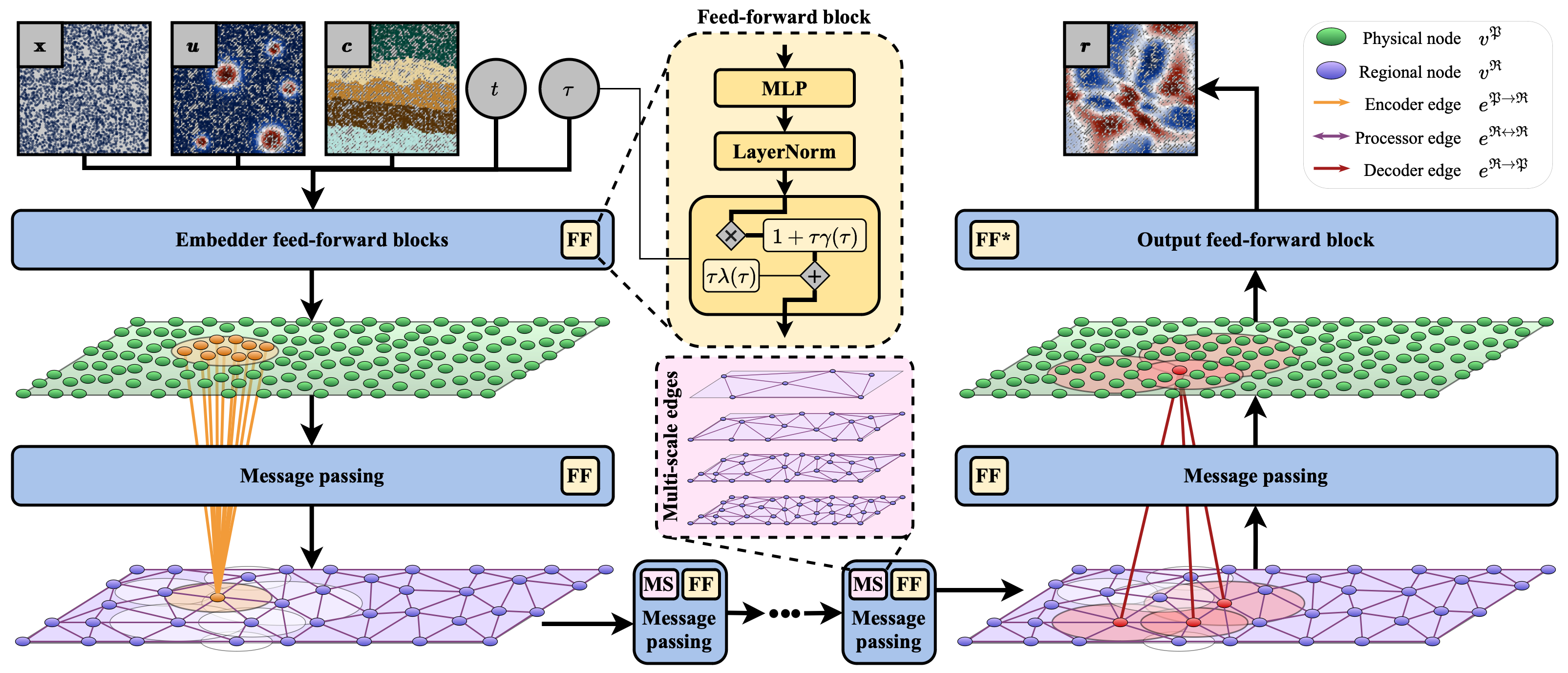 RIGNO: A Graph-based framework for robust and accurate operator learning for PDEs on arbitrary domainsMousavi Sepehr, Shizheng Wen, Levi Lingsch, Maximilian Herde, Bogdan Raonić, and Siddhartha MishraThe 39th Conference on Neural Information Processing Systems, 2025
RIGNO: A Graph-based framework for robust and accurate operator learning for PDEs on arbitrary domainsMousavi Sepehr, Shizheng Wen, Levi Lingsch, Maximilian Herde, Bogdan Raonić, and Siddhartha MishraThe 39th Conference on Neural Information Processing Systems, 2025Learning the solution operators of PDEs on arbitrary domains is challenging due to the diversity of possible domain shapes, in addition to the often intricate underlying physics. We propose an end-to-end graph neural network (GNN) based neural operator to learn PDE solution operators from data on point clouds in arbitrary domains. Our multi-scale model maps data between input/output point clouds by passing it through a downsampled regional mesh. Many novel elements are also incorporated to ensure resolution invariance and temporal continuity. Our model, termed RIGNO, is tested on a challenging suite of benchmarks, composed of various time-dependent and steady PDEs defined on a diverse set of domains. We demonstrate that RIGNO is significantly more accurate than neural operator baselines and robustly generalizes to unseen spatial resolutions and time instances.
2024
- preprint
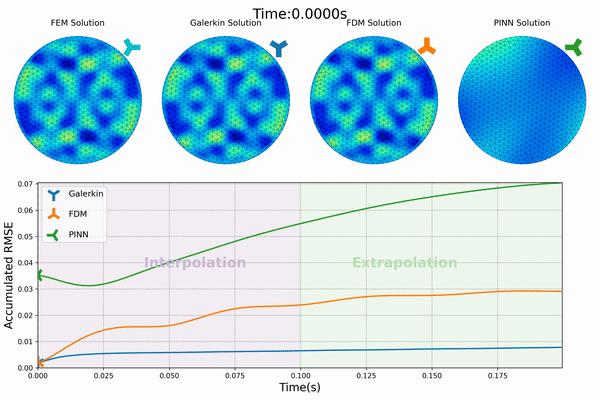 Physics-Constrained Graph Galerkin Learning for Solving Spatio-Temporal PDEsShizheng Wen, Mingyuan Chi, Ben Moseley, Mike Yan Michelis, Pu Ren, and Hao Sununder review, 2024
Physics-Constrained Graph Galerkin Learning for Solving Spatio-Temporal PDEsShizheng Wen, Mingyuan Chi, Ben Moseley, Mike Yan Michelis, Pu Ren, and Hao Sununder review, 2024We introduce the physics-constrained graph Galerkin learning, an approach for solving spatio-temporal partial differential equations (PDEs) that leverages Galerkin discretized variational loss within a graph-based network framework. This method integrates the Galerkin method for spatial discretization with an autoregressive scheme for temporal dynamics. We conceptualize the Galerkin process as a map-reduce operation, where the mapping phase is entirely parallelizable and the reduction phase employs Sparse Matrix Multiplication (SPMM). Leveraging native PyTorch operators ensures seamless and efficient execution across a variety of devices and platforms, while minimizing the computational graph to facilitate rapid back-propagation and boost overall performance. Our method not only achieves training speeds comparable to those of data-driven loss models but also excels in scalability, efficiency, accuracy, and long-term rollouts. Experiments on canonical PDEs, including parabolic and hyperbolic types, demonstrate that our method outperforms previous physical based learning paradigms, such as physics-informed loss and finite-difference-induced loss, as well as data-driven method.
- IJMS
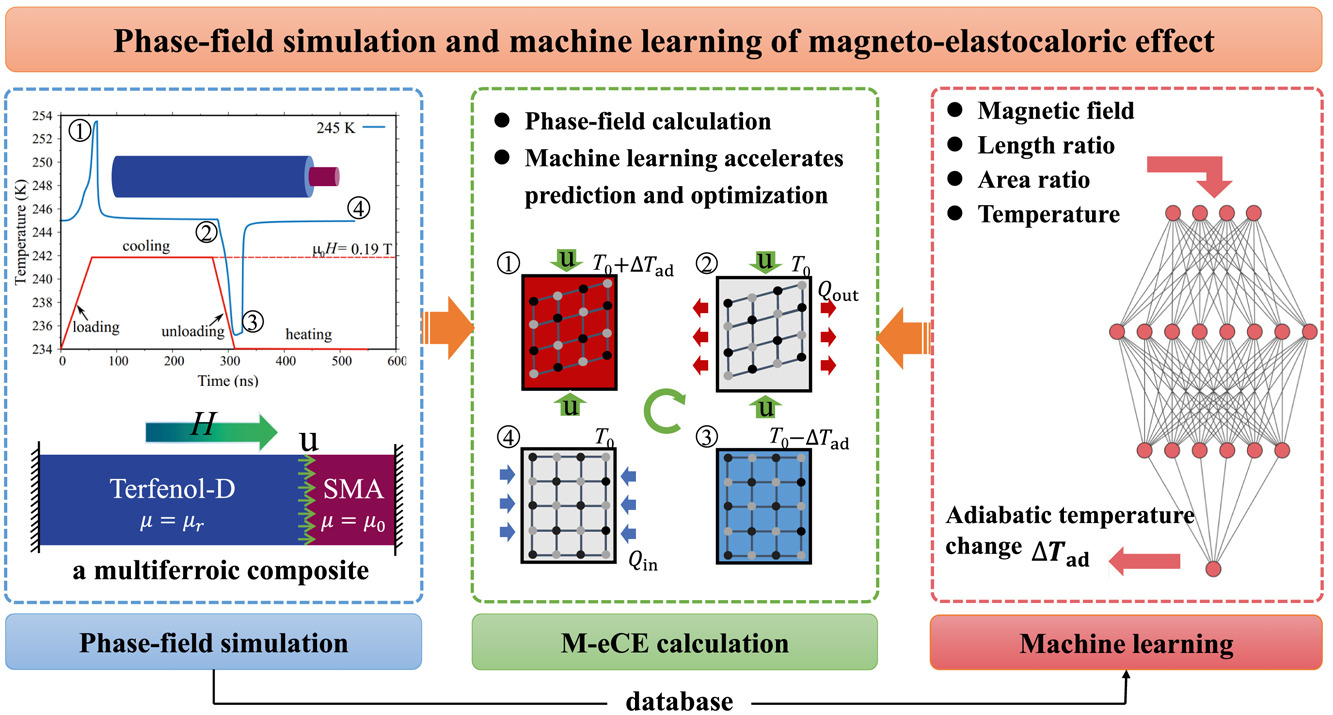 Phase-field simulation and machine learning of low-field magneto-elastocaloric effect in a multiferroic compositeWei Tang, Shizheng Wen, Huilong Hou, Qihua Gong, Min Yi, and Wanlin GuoInternational Journal of Mechanical Sciences, 2024
Phase-field simulation and machine learning of low-field magneto-elastocaloric effect in a multiferroic compositeWei Tang, Shizheng Wen, Huilong Hou, Qihua Gong, Min Yi, and Wanlin GuoInternational Journal of Mechanical Sciences, 2024Achieving appreciable elastocaloric effect under low external field is critical for solid-state cooling technology. Here, a non-isothermal Phase-Field Model (PFM) coupling martensitic transformation with mechanics, heat transfer and magnetostrictive behavior is proposed to simulate Magneto-elastoCaloric Effect (M-eCE) that is induced by magnetic field in a multiferroic composite (e.g., Magnetostrictive-Shape Memory Alloys (MEA-SMA) composite). In the PFM, a nonlinear constitutive hyperbolic tangent model is utilized to model the macroscopic magnetostrictive behavior of MEA, and the heat transfer coupled with phase transformation is employed to calculate the adiabatic temperature change (∆T_ad) during M-eC cooling cycles. The influences of magnetic field, geometrical dimension, and ambient temperature on ∆T_ad are comprehensively investigated. Machine Learning (ML) is further conducted on the database from PFM simulations to accelerate the prediction and design of MEA-SMA composite with an improved ∆T_ad. It is found that a large ∆T_ad of 10–14 K and a wide working temperature window of 30 K can be achieved under ultra-low magnetic field of 0.15–0.38 T by optimizing the composite’s geometrical dimension. The present work combining PFM and ML for evaluating M-eCE provides a theoretical framework for the optimization of M-eC cooling devices, and is also potentially extended to other multicaloric effects (e.g., electro-elastocaloric effect).
2023
- TAML
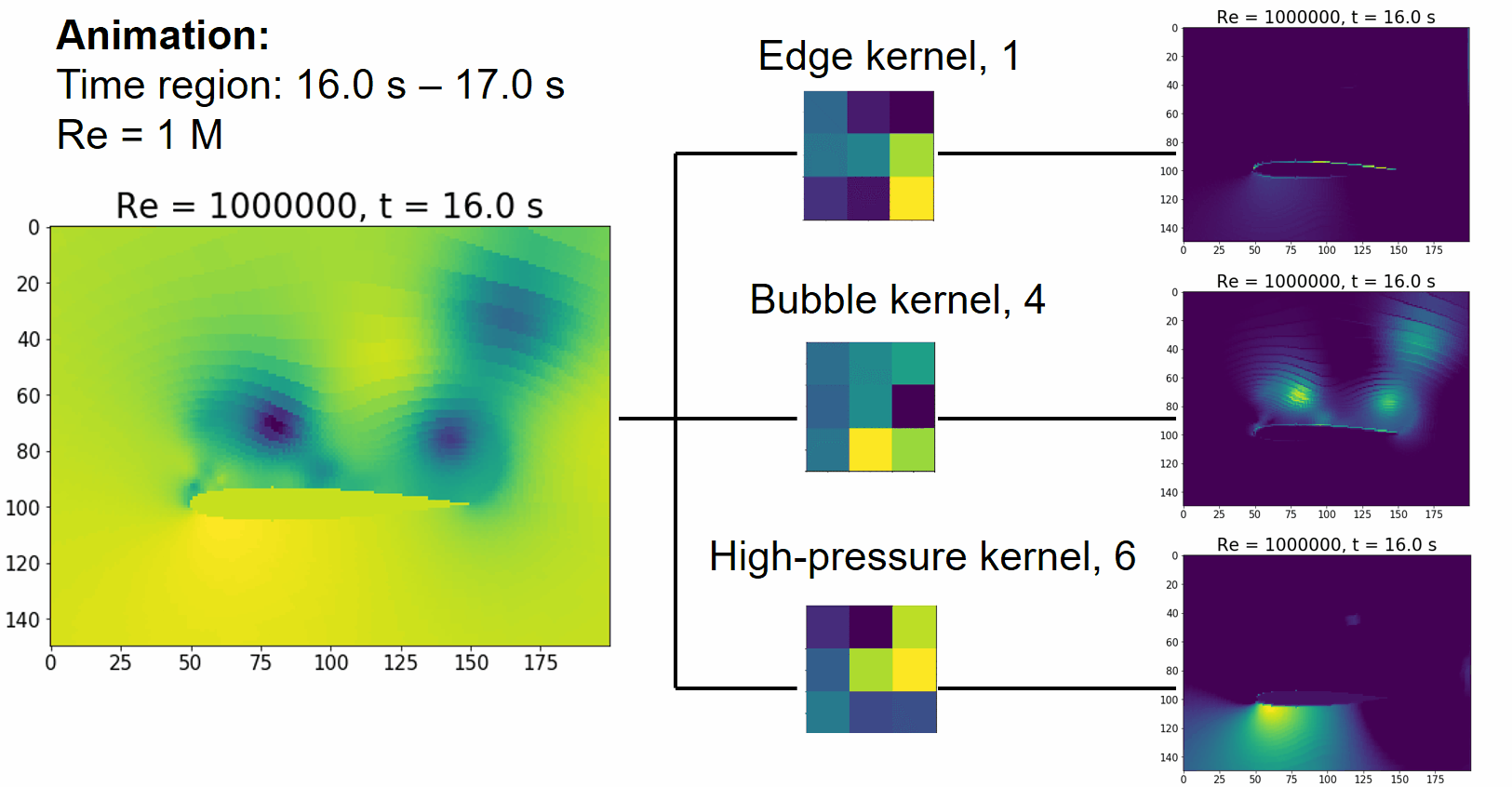 Feature Identification in Complex Fluid Flows by Convolutional Neural NetworksShizheng Wen, Michael W Lee, Kai M Kruger Bastos, Ian Eldridge-Allegra, and Earl H DowellTheoretical and Applied Mechanics Letters, 2023
Feature Identification in Complex Fluid Flows by Convolutional Neural NetworksShizheng Wen, Michael W Lee, Kai M Kruger Bastos, Ian Eldridge-Allegra, and Earl H DowellTheoretical and Applied Mechanics Letters, 2023Recent advancements have established machine learning’s utility in predicting nonlinear fluid dynamics, with predictive accuracy being a central motivation for employing neural networks. However, the pattern recognition central to the network’s function is equally valuable for enhancing our dynamical insight into the complex fluid dynamics. In this paper, a single-layer convolutional neural network (CNN) was trained to recognize three qualitatively different subsonic buffet flows (periodic, quasi-periodic and chaotic) over a high-incidence airfoil, and a near-perfect accuracy was obtained with only a small training dataset. The convolutional kernels and corresponding feature maps, developed by the model with no temporal information provided, identified large-scale coherent structures in agreement with those known to be associated with buffet flows. Sensitivity to hyperparameters including network architecture and convolutional kernel size was also explored. The coherent structures identified by these models enhance our dynamical understanding of subsonic buffet over high-incidence airfoils over a wide range of Reynolds numbers.
2022
- APL
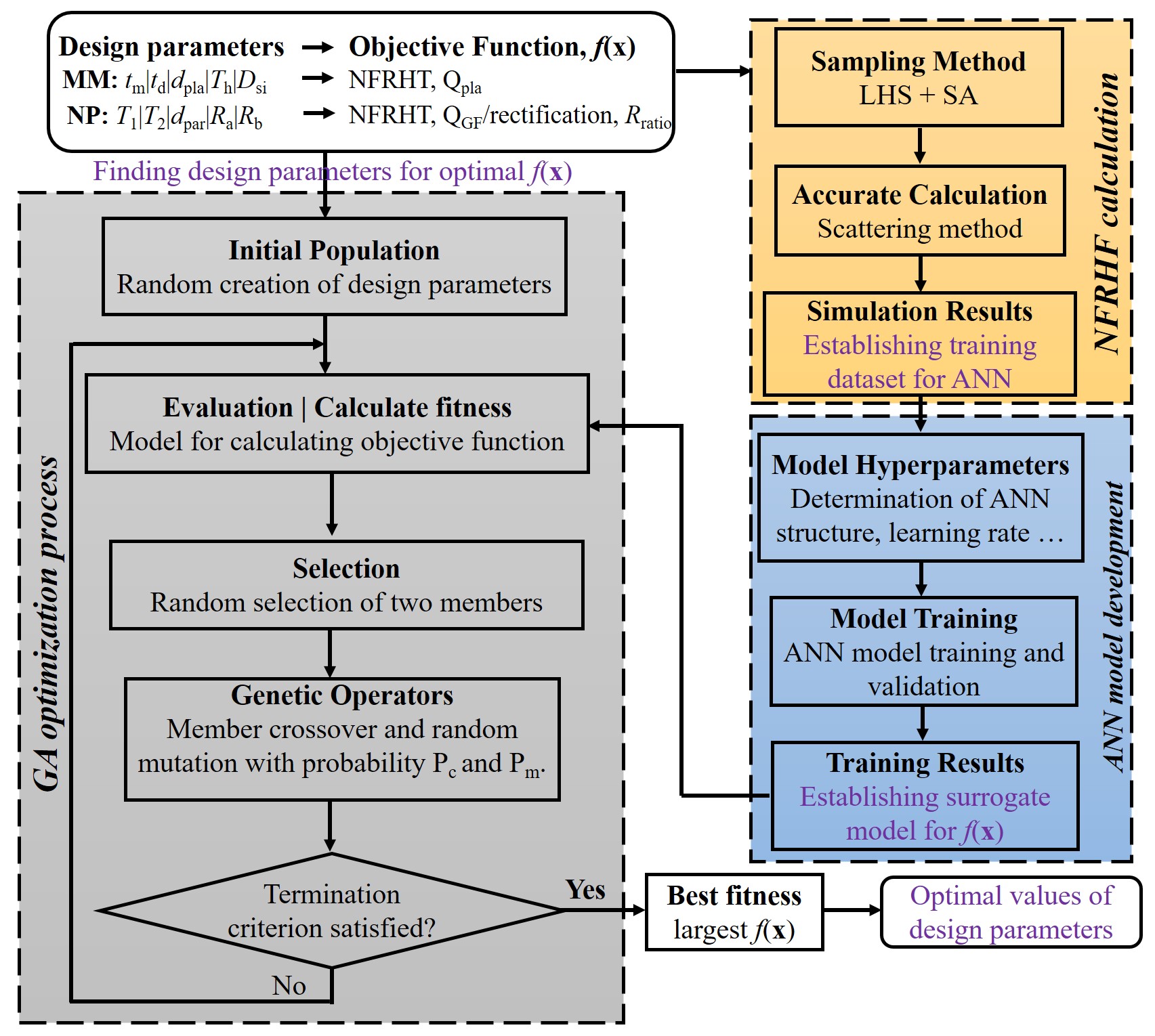 A machine learning strategy for modeling and optimal design of near-field radiative heat transferShizheng Wen, Chunzhuo Dang, and Xianglei LiuApplied Physics Letters, 2022
A machine learning strategy for modeling and optimal design of near-field radiative heat transferShizheng Wen, Chunzhuo Dang, and Xianglei LiuApplied Physics Letters, 2022The past decade has witnessed the advent of near-field radiative heat transfer (NFRHT) in a wide range of applications, including thermal photovoltaics and thermal diodes. However, the design process for these thermal devices has remained complex, often relying on the intuition and expertise of the designer. To address these challenges, a machine learning (ML) strategy based on the combination of artificial neural network (ANN) and genetic algorithm (GA) is presented. The ANN is trained to model representative scenarios, viz. NFRHT between metamaterials, NFRHT and thermal rectification between nanoparticles. The influence of different problem complexities, i.e. the number of input variables of function to be fitted, on effectiveness of the trained ANN is investigated. Test results show that ANNs can obtain the radiative heat flow and rectification ratio accurately and rapidly. Subsequently, physical parameters for the largest radiative heat flow and rectification ratio are determined by the utilization of GA on the trained ANN, and underlying mechanisms of deterministic optimum are discussed. Our work shows that data-driven ML methods are a powerful tool which offers unprecedented opportunities for future NFRHT research.
2021
- JQSRT
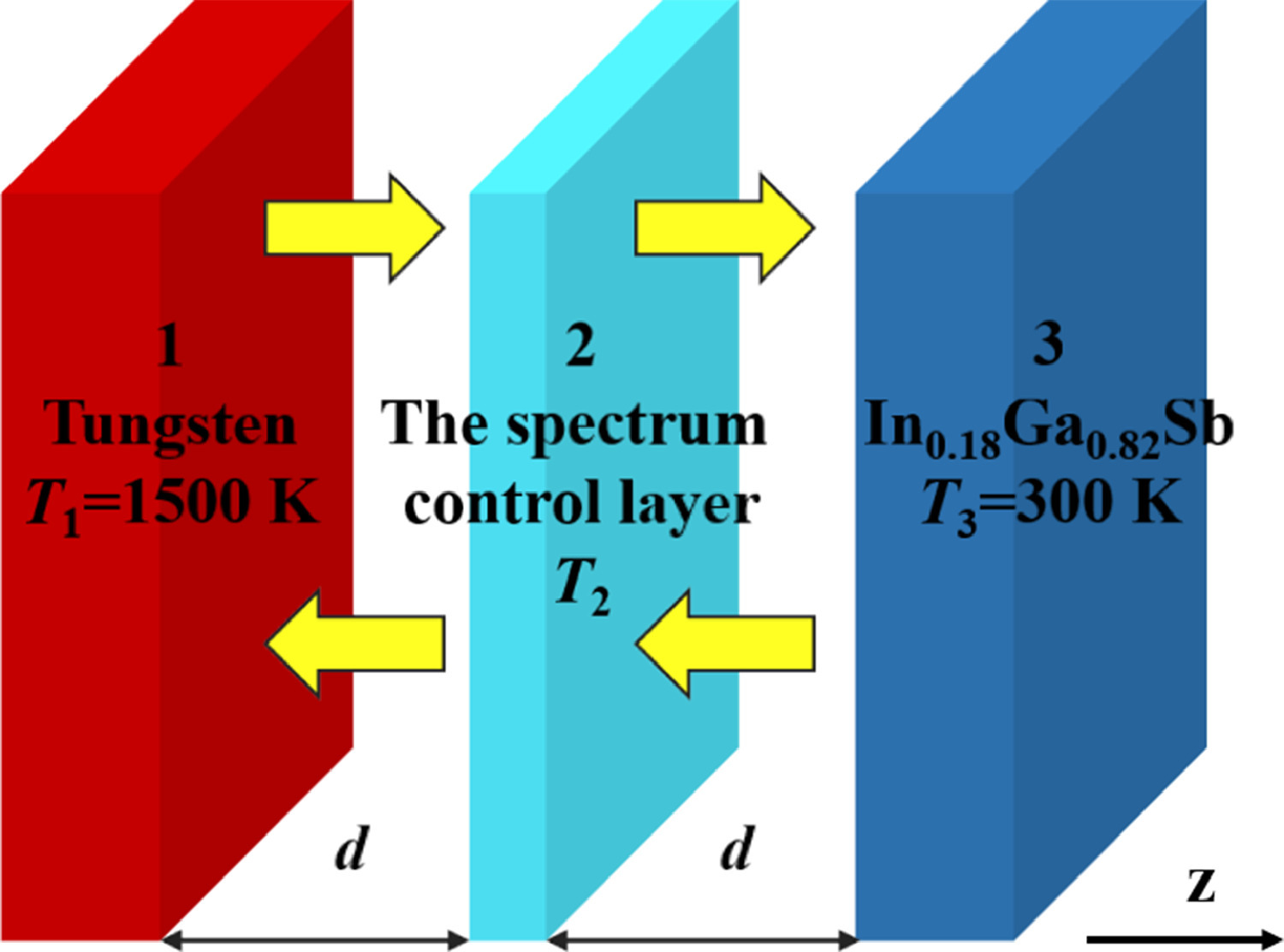 High-performance three-body near-field thermophotovoltaic energy conversionChunzhuo Dang, Xianglei Liu, Haifeng Xia, Shizheng Wen, and Qiao XuJournal of Quantitative Spectroscopy and Radiative Transfer, 2021
High-performance three-body near-field thermophotovoltaic energy conversionChunzhuo Dang, Xianglei Liu, Haifeng Xia, Shizheng Wen, and Qiao XuJournal of Quantitative Spectroscopy and Radiative Transfer, 2021Three-body structures have shown great potentials in enhancing the heat transfer rate and tuning radiation spectrum in the near-field region, whereas are rarely considered in improving near-field radiative energy conversion performance. Here, a three-body thermophotovoltaic system configured by a tungsten emitter, a metallic spectrum control layer, and an In0.18Sb0.82Ga photovoltaic cell is considered. By parameter optimization of the spectrum control layer, the efficiency and output power at the gap distance of 10 nm are enhanced from 24.7% and 1.88×105 W/m2 to 35.3% and 3.62×105 W/m2, respectively. The potential mechanism lies in the excitation of coupled surface plasmon polaritons of the metallic spectrum control layer. This work paves the way for applications of three-body structure in thermophotovoltaic systems and designing high-performance energy conversion systems.
2019
- JQSRT
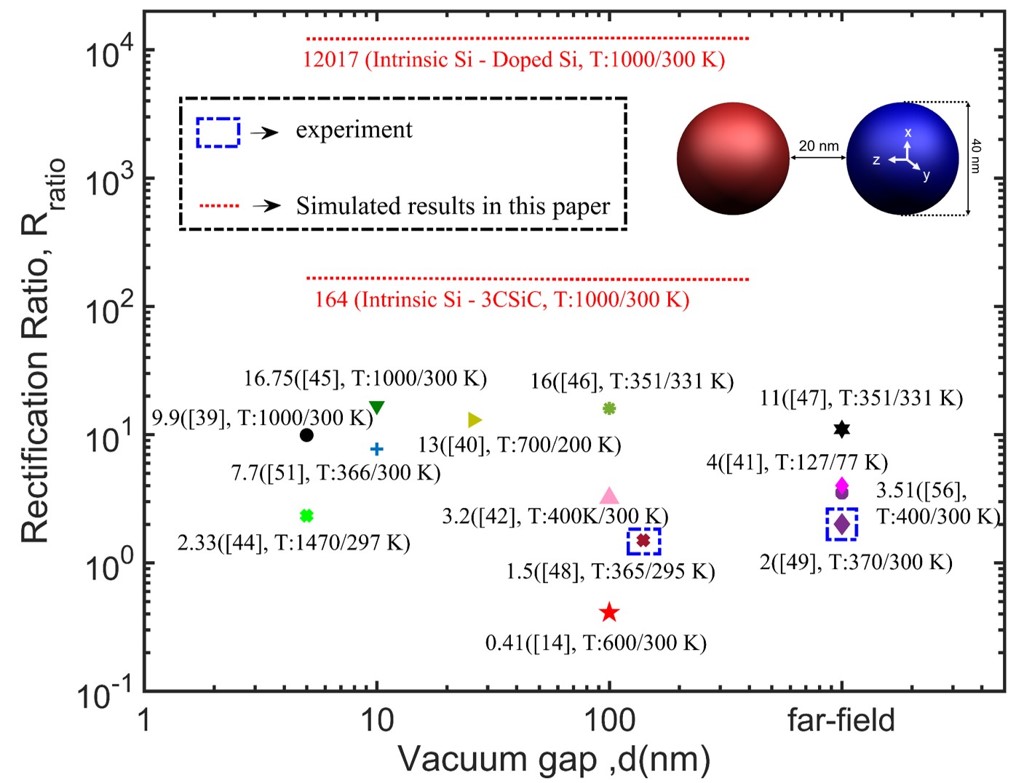 Ultrahigh thermal rectification based on near-field thermal radiation between dissimilar nanoparticlesShizheng Wen, Xianglei Liu, Sheng Cheng, Zhoubing Wang, Shenghao Zhang, and Chunzhuo DangJournal of Quantitative Spectroscopy and Radiative Transfer, 2019
Ultrahigh thermal rectification based on near-field thermal radiation between dissimilar nanoparticlesShizheng Wen, Xianglei Liu, Sheng Cheng, Zhoubing Wang, Shenghao Zhang, and Chunzhuo DangJournal of Quantitative Spectroscopy and Radiative Transfer, 2019The capability of manipulating heat flux at the nanoscale has many promising applications in modern electronics and information processing industries. In this paper, a design to achieve ultrahigh thermal rectification is proposed based on near-field thermal radiation between nanoparticles made of intrinsic silicon and a dissimilar material. A record-high rectification ratio of more than 104 is theoretically demonstrated, and the underlying mechanism lies in the prominent increase of imaginary part of dielectric function of intrinsic silicon induced by thermally excited electrons at high temperatures. Effects of gap distances, materials and configurations of nanoparticles on the rectification ratio are also investigated. This work may pave the way for the design of efficient thermal diodes, thermal transistors, and other thermotronics devices.